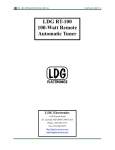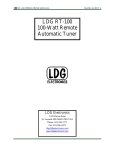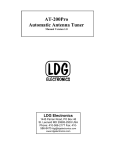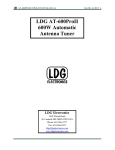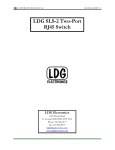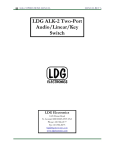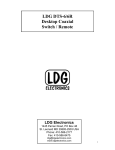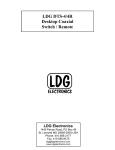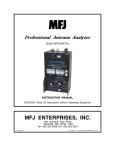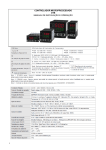Download Alinco DX-SR8 Specifications
Transcript
AL-100 Operations Manual Version 1.0 LDG AL-100 100 Watt Automatic Tuner for Alinco HF Transceivers LDG Electronics 1445 Parran Road St. Leonard MD 20685-2903 USA Phone: 410-586-2177 Fax: 410-586-8475 [email protected] www.ldgelectronics.com 1 AL-100 Operations Manual Version 1.0 Table of Contents INTRODUCTION 3 Jumpstart, or “Real Hams Don’t Read Manuals” 3 Specifications 4 Getting to know your AL-100 7 Front Panel 7 Rear Panel 6 INSTALLATION 7 OPERATION 8 Power-Up 8 Basic Tuning Operation 8 Memory Tuning 8 Full Tuning 9 Bypass Mode 9 Status LED 10 Tune Button Press Summary 10 Application Notes 11 A Word About Tuning Etiquette 12 Care and Maintenance 12 Technical Support 12 Two-Year Transferrable Warranty 12 Out of Warranty Service 13 Returning Your Product For Service 13 Product Feedback 14 2 AL-100 Operations Manual Version 1.0 INTRODUCTION LDG pioneered the automatic, wide-range switched-L tuner in 1995. From its laboratories in St. Leonard, Maryland, LDG continues to define the state of the art in this field with innovative automatic tuners and related products for every amateur need. The AL-100 is custom made for Alinco transceivers, and uses your radio’s TUNE button. Congratulations on selecting the AL-100 100-watt automatic tuner for the Alinco HF transceivers. The AL-100 provides semi-automatic antenna tuning across the entire HF spectrum, at power levels up to 100 watts. It will tune dipoles, verticals, Yagis, or virtually any coax-fed antenna. It will match an amazing range of antennas and impedances, far greater than some other tuners you may have considered, including the built-in tuners on many radios. The AL-100 is similar to previous LDG tuners, but is specially engineered to integrate with Alinco HF radios. The AL-100 connects to the 5-pin tuner port on the back of the radio. The AL100 is powered by the Alinco radio over the tuner interface cable, and tuning is greatly simplified -- you use the TUNE button on the transceiver to start an automatic tuning cycle. You should really read the whole manual, but this summary will get you started. Jumpstart, or “Real Hams Don’t Read Manuals” 1. Turn off power to your Alinco radio. 2. Connect the HF antenna jack on the transceiver to the “TX” jack on the AL100. 3. Connect your antenna’s 50 ohm coax antenna feedline to the “ANT” jack on the AL-100. 4. Connect the 4-pin mini-DIN end of the supplied radio interface cable to the “Radio” jack on the AL-100. 5. Connect the other end of the radio interface cable to the radio’s 5-pin tuner jack. 6. Turn on the radio and select the desired operating frequency and mode. 7. Consult your radio’s manual on how to activate the external tuner. On most Alinco HF radios, press FUNC and then TUNE. The transceiver automatically keys up with a minimal amount of power, and the AL-100 begins a tuning cycle. At the end of the tuning cycle, the original mode and power level is restored. 8. You’re now ready to operate! 3 AL-100 Operations Manual Version 1.0 Specifications Specifications. Always operate within these limits. • 0.1 to 100 watts SSB and CW peak power, 30W on digital modes. • Latching relays for ultra low power operation. • 200 memories for instantaneous frequency and band changing. • Powered and controlled via radio interface cable. • Designed specifically for Alinco HF transceivers. • 1.8 to 54.0 MHz coverage. • Tunes 4 to 800 ohm loads (16 to 150 on 6M), 16 to 3200 ohms with optional 4:1 Balun. • For Dipoles, Verticals, Vees, Beams or any Coax Fed Antenna. • Dimensions: 5.5” W x 6.0” D x 1.2” H. • Weight: 1 lb IMPORTANT SAFETY WARNING Never install antennas or transmission lines over or near power lines. You can be seriously injured or killed if any part of the antenna, support or transmission line touches a power line. Always follow this antenna safety rule: the distance to the nearest power line should be at least twice the length of the longest antenna, transmission line or support dimension. 4 AL-100 Operations Manual Version 1.0 Getting to know your AL-100 You’ll be using your AL-100 for a long time; take a few minutes to get to know it. Your AL-100 is a quality, precision instrument that will give you many years of outstanding service; take a few minutes to get to know it. The AL-100 is designed for use with Alinco HF radios. Tuning is performed by pressing the TUNE button on the front of the transceiver. The tuner can be placed in bypass mode by pressing the Tune button on the tuner momentarily. The AL-100 is powered by the radio via the radio interface cable; no separate power supply is needed. Latching relays hold the tuned configuration indefinitely, even when DC power is completely removed. Tuning memories are stored indefinitely in flash memory. The AL-100 has 200 frequency memories. When tuning on or near a previously tuned frequency, the AL-100 uses “Memory Tune” to recall the previous tuning parameters in a fraction of a second. If no memorized settings are available the tuner runs a full tuning cycle, storing the parameters for memory recall on subsequent tuning cycles on that frequency. In this manner, the AL-100 “learns” as you use it, adapting to your bands and frequencies as it goes. Front Panel There is only one control button and one status light, but they do lots of different things. On the front panel there is one pushbutton and one LED indicator light. • Tune button: selects Memory Tune, Full Tune or Bypass • Status LED: Blinks to indicate tuner status. 5 AL-100 Operations Manual Version 1.0 Rear Panel The rear panel has standard SO-239 sockets for input and output, a 4-pin DIN socket for radio connection, and a ground post. The rear panel of the AL-100 features four connectors: • Ant connector: Connect the 50-ohm coax antenna feedline to this standard SO-239 connector. • GND connector (wing nut): Connect to earth ground. • TX connector: Connect a 50-ohm coax jumper cable from this standard SO239 connector to the antenna jack on the back of your transceiver. • Radio connector: Use the supplied cable to connect to your radio’s Tuner jack. 6 AL-100 Operations Manual Version 1.0 INSTALLATION Your AL-100 is not water resistant; keep it dry. Turn your radio off before you install the tuner. The AL-100 tuner is designed for indoor use only; it is not water resistant. If you use it outdoors (Field Day, for example) you must protect it from rain. The AL-100 is designed for use with coax-fed antennas. You need a balun to use your AL-100 with longwires or antennas fed with ladder line. The LDG RBA4:1 or RBA-1:1 are ideal, depending on the antenna and transmission line used. Always turn your radio off before plugging or unplugging anything. The radio may be damaged if cables are connected or disconnected while the power is on. Your AL-100 tuner is compatible with the following Alinco HF transceivers: The AL-100 radio interface cable won’t work with any other radios. Connect your AL100 to your antenna and transceiver using the shortest practical coax runs. • DX-70 • DX-77 • DX-SR8 DX-SR9 WARNING: Do not attempt to use the AL-100’s radio interface cable with any other transceivers, even if the plug fits. At best, the AL-100 simply won’t work with these radios. At worst, it could cause damage to either the AL-100, the radio, or both. Connect the ANT output of the transceiver to the TX input on the rear of the AL-100. Then connect the antenna feedline to the Ant jack on the AL-100. Carefully line up the guide pin on the 4-pin mini-DIN plug on the provided cable with the socket on the back of the AL-100 and connect. Connect the 5pin plug on the other end of the cable to the jack marked “Tuner” on the rear of the Alinco transceiver. Grounding the AL-100 tuner will enhance its performance and safety. LDG recommends that you connect your tuner to a suitable ground; a common ground rod connected to buried radials is preferred, but a single ground rod, a cold water pipe, or the screw that holds the cover on an AC outlet can provide a serviceable ground. LDG strongly recommends the use of a properly installed, high quality lightning arrestor on all antenna cables. 7 AL-100 Operations Manual Version 1.0 OPERATION Your AL-100 is powered by your radio. You can let your AL100 handle tuning automatically, or you can start a tuning cycle manually if needed. Your AL-100 saves tuning parameters so it can tune instantly when you return to that frequency. Power-Up Turn on the transceiver. The LED on the front panel of the AL-100 will blink once. If it doesn’t, turn off the radio and recheck your connections. Basic Tuning Operation Tuning operation is controlled by the FUNC/TUNE buttons on your Alinco transceiver. The radio will transmit a carrier and the tuner will perform an automatic tuning cycle. You can also control your tuner from its front panel using the Tune button1. There are two types of tuning cycle: memory tuning and full tuning. Memory tuning restores tuning parameters stored after a previous successful tune on or near the present frequency. Memory tuning is the default mode. A full tuning cycle “starts from scratch”, usually on a new frequency, and begins a tuning sequence in which the AL-100 rapidly tries various combinations of inductance and capacitance to find the best match possible. If an acceptable match is found (SWR < 1.7), the settings are saved in a memory associated with the current frequency so that they may be quickly recalled in the future via a memory tuning cycle. In this manner, the AL-100 “learns” your preferences; the longer you use it, the more closely it adapts itself to your favorite bands, frequencies and antenna characteristics. You will probably use memory tuning most of the time; it takes advantage of any saved tuning settings, but automatically reverts to a full tuning cycle if no stored data is available. At the end of a tuning cycle the carrier is held for one second so that you can read the final SWR on the transceiver’s internal SWR meter or another inline SWR meter between the radio and tuner. The Status LED will also indicate the status of the tuning cycle. Memory Tuning Memory tuning is the default mode; you’ll probably use it most of the time. To start an automatic tuning cycle press FUNC/TUNE on your Alinco transceiver as described in your Alinco radio manual. The AL-100 will cause the transceiver to transmit a carrier for the duration of the tuning cycle, and the Status LED on the AL-100 will light while tuning. The AL-100 will perform 1 For DX-70 and DX-77 the radio must be in AM or FM mode. The DX-SR8 does not work with the tune button on the tuner. 8 AL-100 Operations Manual Version 1.0 a memory tuning cycle if data from a previous tune on the present frequency is available. Otherwise, it will perform a full tuning cycle, storing the tuning parameters for future memory tunes. When tuning is complete, the transceiver will return to receive mode. The Status LED on the AL-100 will blink to indicate the status of the match (see table below for blink codes). Watch the transceiver’s built-in SWR meter or use an inline SWR meter between the radio and the tuner for a more precise SWR reading. To start a memory tune from the tuner’s front panel, transmit a carrier (AM, FM, or CW) and press the Tune button until the Status LED lights. Release the Tune button, but keep the radio keyed, and wait for the memory tuning cycle to end. Full Tuning You can force a full tuning cycle if needed by pressing and holding the Tune button. In some cases you may want to perform a full tuning cycle even when memory parameters are available. For example, you may have moved the antenna, slightly changing its characteristics. You can force a full tuning cycle that will cause the AL-100 to seek a better match than the one already stored in memory for this frequency. To start a full tune from the tuner’s front panel, transmit and hold a carrier (AM, FM, CW) then press the Tune button and hold the Tune button for more than 3 seconds, until the Status LED lights and then goes out, then release. Keep the radio keyed for the full tuning cycle to end. Bypass Mode Press the Tune button momentarily to toggle between active and bypass modes. You may place the tuner in “bypass” mode, connecting the transmitter directly to the antenna; no matching will be performed. To toggle between bypassed and active mode, press the front panel Tune button on the AL-100 momentarily (0-1 sec) and release. The Status LED will flash three times to indicate that the tuner is in bypass mode. Press the front panel Tune button momentarily again to recall the previous tuner settings. The Status LED will flash once to indicate that the tuner is no longer bypassed. This function is useful when you wish to compare antenna performance with and without the benefit of the tuner’s matching network. 9 AL-100 Operations Manual Version 1.0 Status LED The Status LED displays many different kinds of information. The Status LED is used to indicate various operating modes, tuning status, and error conditions. The followings table lists the LED status codes and their meaning. Status LED Indication Meaning On Steady When Tuning Tuning In Process Blinks 1 Time After Tune Good Match Found <1.7 Blinks 2 Times After Tune Medium Match Found >1.7 And <3.0 Blinks 3 Times After Tune No Match Found Blinks 4 Times After Tune No RF Present For Tuning Blinks 5 Times After Tune RF Lost During Tune Blinks 3 Times Tuner Set To Bypass Blinks 1 Time Tuner Set To Previous Match Tune Button Press Summary The Tune button has three functions, depending on how long you hold it down. The tuner’s Tune button has three functions, depending on length of press: • Bypass toggle: short press (0 - 1 second) • Memory tune: medium press (1 - 3 seconds) LED will come on • Full tune (disregards memory): long press (more than 3 seconds) LED will come on for three seconds, then go off. 10 AL-100 Operations Manual Version 1.0 Application Notes Here are some helpful notes on using your AL-100. Base Station Operation Install your AL-100 in a convenient spot near your operating position. Connect to your Alinco transceiver using the cable provided. Connect the tuner to the antenna connecter of the transceiver using the shortest practical coax cable, and connect the antenna to the tuner’s Antenna connector. LDG recommends a properly rated and installed lightning arrestor in the antenna lead, and a ground wire from the ground post on the AL-100 rear panel to a suitable earth ground. Mobile Operation The AL-100 is perfectly suited to mobile operation. It can be installed under the dashboard along with the transceiver, or mounted remotely. The only requirement is that the tuner remain dry. Performance will be enhanced if the AL-100 is well grounded to the car’s body and frame. MARS/CAP Coverage The AL-100 provides continuous tuning coverage over its specified range, not just in the ham bands. This makes it useful for MARS or CAP operation, or any other legal HF operation. You can program the MF key on the DX-SR8T to perform the FUNC/TUNE function. DX-SR8T “MF” Key Shortcut Setup The Alinco DX-SR8T has an option to simplify tuning. Rather than having to press FUNC and then TUNE each time a tune is needed, the DX-SR8T radio allows programming the MF key to perform the same operation as FUNC/ TUNE with a single button press. In order to program the MF key to begin a tune, connect the radio to a suitable antenna or dummy load. Then, with the DX-SR8 turned on, perform the following: • • • • • • Press the FUNC button on the DX-SR8T Press the MF key Press the FUNC key again Press the TUNE (decimal point) key Wait for the tuning cycle to end Press the MF key again Now you can simply press the MF key on the DX-SR8T to begin tuning. 11 AL-100 Operations Manual Version 1.0 A Word About Tuning Etiquette Don’t be a Lid! Be careful not to interfere with other stations when you tune. Be sure to use a vacant frequency when tuning. With today’s crowded ham bands, this is often difficult. However, causing interference to other hams should be avoided as much as possible. The AL-100’s very short tuning cycle minimizes the impact of tuning transmissions. Care and Maintenance The AL-100 tuner is essentially maintenance-free. You should always strictly observe the power limits specified in this manual. The outer case may be cleaned as needed with a soft cloth slightly dampened with household cleaning solution. As with any modern electronic device, the AL-100 can be damaged by temperature extremes, water, impact, or static discharge. LDG strongly recommends the use of a good quality, properly installed lightning arrestor in the antenna lead. Email if you have questions or need help. Your two-year warranty is transferable if you sell or give your tuner to someone else. Technical Support The LDG customer support staff is ready to answer your product question by e-mail [email protected]). You can also check the FAQ section of our web page. LDG also keeps on-line product information up to date on our web site, including product manuals, just in case you lose this one! When you are thinking about the purchase of other LDG products our website also has complete product specifications and photographs you can use to help make your purchase decision. Don’t forget the links to all of the quality LDG Dealers also ready to help you make that purchase decision. Two-Year Transferrable Warranty Your product is warranted against manufacturer defects in parts and labor for two full years from the date of purchase. This two-year warranty is also transferrable. When you sell or give away your LDG product, give the new owner a copy of the original sales receipt and the two-year warranty goes with the new owner. There is no need to complete a warranty card or to register an LDG product. Your product receipt establishes eligibility for warranty service, so be sure to save your receipt. Send a copy of the receipt with the product whenever you send your product to LDG for warranty repair. Products sent to LDG without a receipt are considered requests for out-of-warranty repair. LDG does not warranty against product damage or abuse. This means that a 12 AL-100 Operations Manual Version 1.0 product failure, as determined by LDG, to be caused by the customer or by other natural calamity (e.g. lightning) is not covered under the two-year warranty. Damage can be caused by failure to observe the product’s published limitations and specifications, or by not following good Amateur practice. Out of Warranty Service We’ll be happy to fix your tuner even if it’s out of warranty. Pack it carefully, include your receipt for warranty service, and ship it to us; no RMA is required. If a product fails after the warranty period, LDG wants to help you get it fixed. Send the product to us for repair any time you like. We will determine what needs to be done and based on your instructions, either contact you with an estimate or fix it and contact you with a request to pay any repair charges. Please contact LDG if you have any questions before you send us an out ofwarranty product for repair. Returning Your Product For Service Returning a product to LDG is easy. We do not require a return merchandise authorization, and there is no need to contact LDG to return your product. Visit the LDG web site and download the LDG Product Repair Form. On the Repair Form tell the LDG technicians exactly what happened or didn’t happen and why you believe the product needs servicing. The technician attempts to duplicate the problem(s) you had based on how well you describe it so take the time to be accurate and complete. Ask your shipper for a tracking number or a delivery verification receipt. This way you know the product arrived safely at LDG. Be sure to give us your email address so our shipper can alert you online when your product is en-route back to you. Please be assured that our staff makes every effort to complete repairs ahead of our published wait time. We patience appreciate your patience; repairs can take six to eight weeks, but are often faster. The most recent information on returning products for service is found on the LDG website under Support, then Tech Support. Send your carefully packaged unit with the Repair Form to: LDG Electronics, Inc. Attn: Repair Department 1445 Parran Rd St. Leonard, MD 20685 13 AL-100 Operations Manual Version 1.0 Product Feedback Keep those cards, letters and emails coming; we love to hear from our customers. We encourage product feedback! Tell us what you think of your LDG product. In a card, letter, or email (preferred) tell us how you used the product, how well it worked in your application, and any suggestions you have for enhancements or new products. Send along a photo or even a schematic or drawing to illustrate your narrative. We like to share your comments with our staff, our dealers, and even other customers at the LDG website: http://www.ldgelectronics.com/ 14














